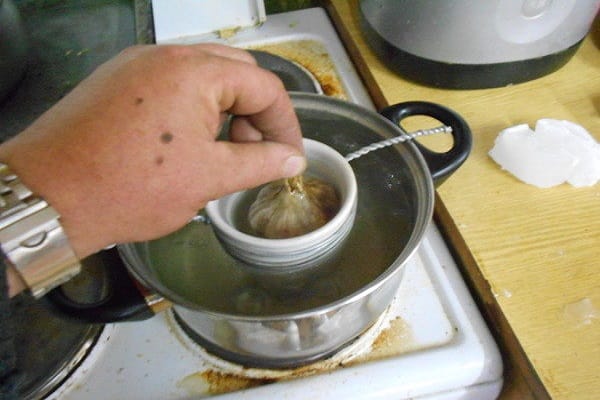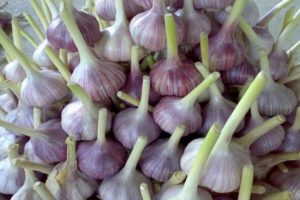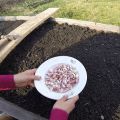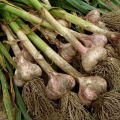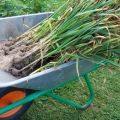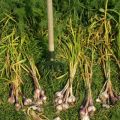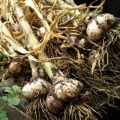When is it necessary to dig up garlic in the Samara, Volgograd and Ulyanovsk and Saratov regions?
Garlic is one of the important foods that improve the taste of meat dishes and salads, which may have to be dug up later in 2018. This agricultural crop is grown both in the Moscow region and in the Vladimir, Ulyanovsk, Volgograd, Samara regions, in Bashkiria. In the northern regions of Russia, garlic is sown for the winter in the last days of August, in the southern part it is planted until the end of October, therefore it ripens at different times.
The exact date of harvest depends on the climatic characteristics of the area, but belated and premature digging of the heads reduces the shelf life.
Types of garlic
The culture is demanding on soil and light. It is grown on loam and sandy soil, in beds illuminated by the sun. The product, which is a natural antibiotic, contains many vitamins, organic acids and trace elements. Spring garlic planted after the snow melts in April, in early May, when the ground warms up to 5 degrees. It is not afraid of frost, but reproduces only by cloves, which require additional days for germination.
Winter garlic must be sent to the ground at a specific time. With an early planting, it sprouts and can freeze, with a late one, the culture does not always have time to take root before the onset of frost. In order for the plant to endure the cold normally, the beds are mulched with peat, needles with sawdust or dry leaves, in the absence of snow they are covered with plastic wrap.

Winter varieties reproduce not only by cloves, but also by bulbs, which are formed on the arrows. This method of sowing allows you to renew the planting material, to enlarge the heads, since they gradually become significantly smaller in size.
When to harvest garlic?
The harvesting time of a crop depends on its variety, climatic conditions. The weather speeds up or delays the maturation of the bulbs. Winter species usually ripen by July:

- in the southern part - by 10–12;
- in the central regions - by the middle of the month;
- in the northern regions - in the last days.
Dry and hot summers slow down the development of this plant, rains promote its growth. To know when to dig garlic, you need to look not only at the calendar, but also to monitor the appearance of some signs. Even if the harvest is 3 days later, the heads:
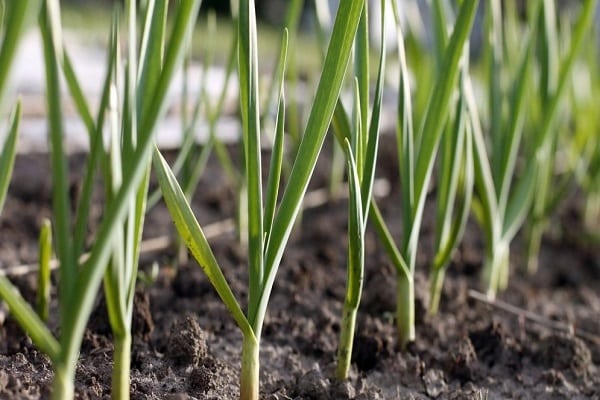
- Will break up into cloves.
- Lose the garlic flavor.
- Will not be stored.
Unripe bulbs have a dense skin and a thick neck. They lose their medicinal properties and dry out quickly.
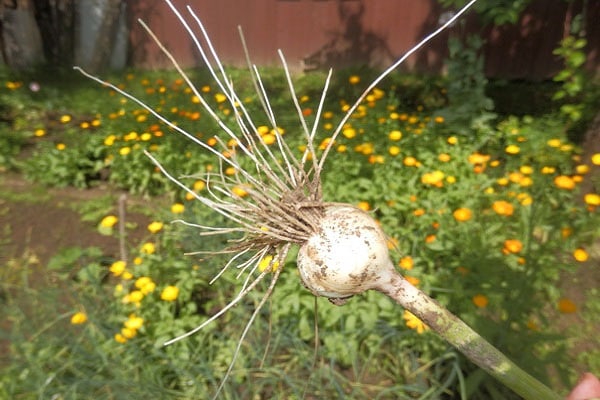
When it is impossible to name the exact date in the Saratov region, winter crops are usually harvested at the end of July, in Volgograd - a week earlier, in Samara, Ufa - a little later.
Harvesting begins if all the lower leaves have acquired a yellow tint and lay on the ground, the boxes on the arrows, in which the seeds are located, open. The hard heads must be dug out before they fall apart into cloves, otherwise the bulbs will become loose, lose flavor or sprout.
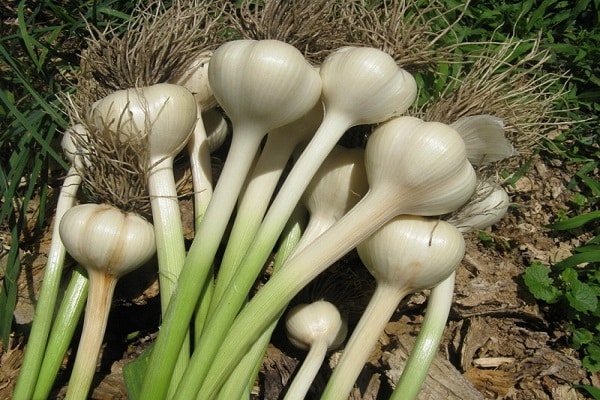
When to dig up spring garlic?
Signs that indicate that the bulbs are ripe should be known to all gardeners, regardless of the regions in which they grow this crop. Spring garlic, unlike winter varieties, does not have arrows and bolls with seeds, which serve as one of the landmarks for preparing for harvesting. The leaves can change color in unfavorable weather, and if they turn yellow at the bottom, and the upper ones remain green, but lay down, then the heads are ripe.
They must be firm, not disintegrating in the hands, and the husks peel off easily.
The growing season of spring varieties is from 3 months to 120 days, but the cloves after planting need time to germinate, so you need to dig spring garlic two weeks later than winter. Varieties that are planted in spring are stored better, they try to remove the heads until mid-September, and begin at the end of August.
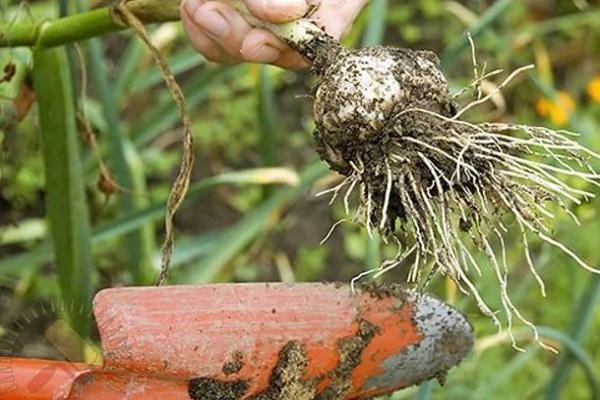
Preparing and collecting bulbs
When you have to dig garlic in 2018 - later or earlier it is curled by the weather, spring is late, no one knows what the summer will be like. Winter varieties ripen no earlier than 100 days after the sprouts emerge from the ground. With an excess of moisture, the bulbs can rot and will be poorly stored. Therefore, from the end of June, watering stops, the soil is raked away. The harvesting process consists of several stages:
- The heads are undermined with a pitchfork or a shovel, cleared of the ground.
- Garlic is laid out in rows on an open terrace for 5 days.
- Some of the feathers are removed, the bulbs are covered with them from the rays of the sun.
- The dried roots are cut off, leaving a couple of millimeters, the ends are burned with fire.
- The heads are sorted by size, the material for the next planting is selected from them.
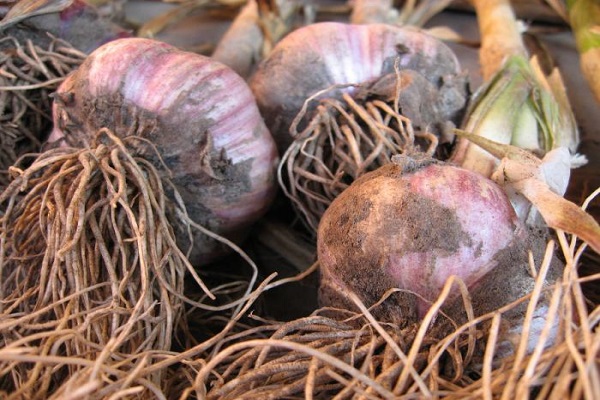
Arrows with inflorescences are harvested a week before harvesting, tied in bunches. The seeds in them quickly ripen and are planted for the next season. Work on digging out the bulbs is carried out in clear weather. It is advisable to do this in the morning or evening.
If possible, dry the garlic in the sun. The bulbs will not hurt, but will die:
- nematodes;
- ticks;
- fungi;
- microbes.
To clean the dirt from the dug heads, summer residents first wash them in water, remove the scales. This treatment is suitable for a small number of bulbs. After the water drains, the garlic is laid out on a burlap and air dried.
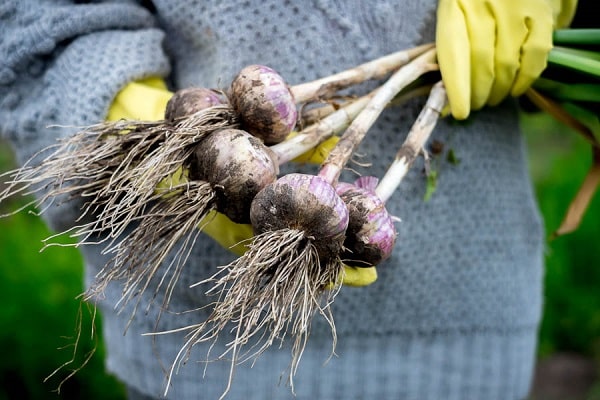
Storage methods
The culture is planted in different regions. Both Ufa and Penza can boast of new winter and spring varieties, which are adapted to the conditions of the local climate and give a high yield.
Subject to the storage rules, ripe unpeeled heads of spring garlic do not dry out, do not rot until the next season.
The bulbs are placed in boxes or jars filled with sawdust, wood ash, sand or salt so that there is no free space. Due to the lack of oxygen, neither fungi nor microbes start.
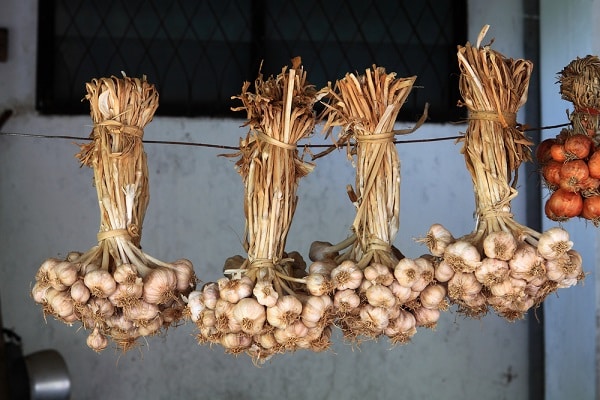
In a sealed container at a temperature of 3-5 degrees, the heads of winter varieties are stored until January, the spring varieties do not lose their quality characteristics even at 17-19.
In a country house, where it is dry and cool, bundles of bulbs are hung. Such wreaths or braids look original and fill the room with a pleasant aroma. If it is warm or humid, the heads will sprout and become moldy. The teeth will become tasteless if the air is very dry.
Garlic is well kept together with husks or moss in cotton or linen bags. These natural ingredients absorb excess moisture.
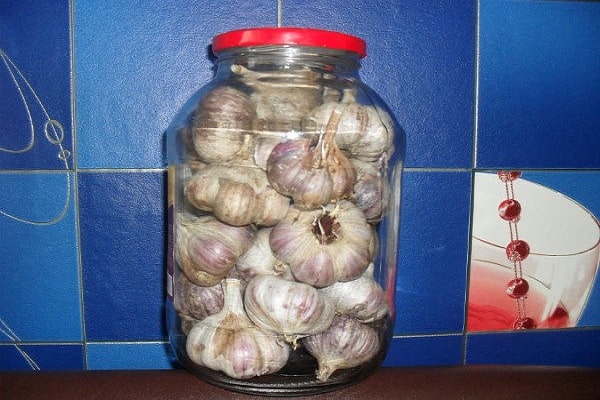
The bulbs do not rot, do not lose their taste when their surface is treated with molten paraffin. A large number of heads are placed in vegetable nets, which are best hung on the walls.For storing garlic, wicker baskets, boxes, made of cardboard and wood, if you cut openings in them for air circulation, are suitable.
The peeled cloves are washed, put in a jar and poured with olive or corn oil. The container is closed and placed in a refrigerator. However, no storage method will give a positive result if the heads are collected at the wrong time, began to crumble, and are poorly dried.

Farmers who plant entire fields with winter varieties of garlic for subsequent sale, the bulbs are treated with special compounds such as radioactive cobalt. Such a product is stored not for 4, but for 6 or 8 months, does not harm the human body. It will not be possible to grow a garlic crop in oneself by choosing seed from the heads, since the teeth do not sprout after processing.
